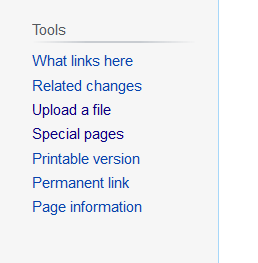Appropedia encourages using supporting media to make content more informative, especially media that supports multilingual learning. A great variety of file types are allowed on Appropedia: documents, presentations, videos, vector images, audio, and photographs, for example. Here are some instructions and guidelines on including media on your page.
Uploading[edit | edit source]
Before uploading, please ensure that the content is owned by you or have legal rights to upload and redistribute it in a way that grants the same rights to the community. Appropedia uses the CC BY-SA license as a default but welcomes content with other copyleft licenses such as GNU GPL (see Appropedia:Copyrights for more information on our approach to licensing).
- Here is what you need to know about uploading files
- Make sure to locate the file on your computer that you will upload.
- We strongly recommend using open, editable file formats
- For photos
- Reduce photo sizes to less than 4MB to help us save disk space.
- The preferred formats are JPEG for photographs and PNG for technical drawings.
- Also, make sure to rotate the images to the proper orientation.
- To upload any file

- Click on the Special:Upload link located at the toolbox menu.
- Click the "Browse..." button on the "Upload file" page, and select the file on your computer.
- Select the destination name of your file. Ensure that the filename is original (if not, add the date to the start of the filename).
- Enter a summary (this step is optional but will be useful for others who view the file in the future).
- The summary section is a great place to indicate how you obtained the file (if you created it or attribute the original author).
- To finish the upload, press the "Upload file" button. You will have to wait, depending on your Internet connection.
- Once your file is uploaded, you will probably want to put it on your page. This is done by adding [[File:Filename]] to the text.
Please note that others may edit your uploads (and admins may delete them) if necessary. Also, any attempts to abuse the system may get you blocked from uploading.
Embedding content[edit | edit source]
If you have uploaded videos or documents to other platforms such as YouTube or Google Docs, you can get an embed code that will show on Appropedia pages. We don't have a strict policy that encourages or admonishes using embed codes, so you are free to consider whether to do so by considering the following possibilities.
- Things to consider before embedding files
- External sites sometimes break or become unavailable over the years. Once a site goes down or accounts are closed, content is usually lost for good.
- Many sites do not allow users to download the content; this might become increasingly difficult due to legal restrictions around web scraping.
- External hosting is useful for files too large to be stored on Appropedia (e.g., using YouTube or Vimeo to store videos).
- Sometimes it is possible to reduce the file size by switching formats. Consider using text-based
Before embedding files from an external source, consider using text-based formats that allow porting into other formats. Markdown is a very powerful, yet portable alternative that you should consider. Here are some examples:
- Documentation
- R Markdown Books use the R flavor of Markdown to generate technical publications.
- Jupyter Notebooks is a text-based tool that generates digital notebooks for reproducible research.
- LaTeX
- Presentations
- Format translation: Pandoc
Finally, consider uploading your content to archive repositories such as The Internet Archive to ensure that your project lives on over the years.
Avoid huge image files[edit | edit source]
Huge image files should be avoided, as they can make pages load slowly. This is an accessibility issue to consider especially for remote or underdeveloped areas. Usually, the file should be compressed to 4 MB or less, even for a very large or detailed picture. Photos from digital cameras can be bigger than 5 MB, which is often unnecessarily large.
An image editing tool can help you resize it. An excellent open-source program to open and edit files is ImageMakick. Another good image viewer (for Windows) is IrfanView. To give you an idea, a fairly large image (1920x1080, Compressed JPG 100% 24bit/pixel) may still weigh around 500 kb.
To learn more about file types and file size calculation, please reference: https://en.wikipedia.org/wiki/Image_file_formats